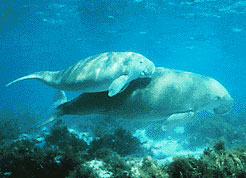


In celebration of Valentine's Day, here are a few romance-inspired treasures in Australia's Great Barrier Reef.
1. Heart Reef, in the Whitsunday Islands (how romantic!)
2. Clownfish-- all clownfish are born as males, but when their female breeding partner dies, the males change into females. Crazy stuff.
3. Red Throat Emperor (if you look closely, the tail fin looks like a red heart... )
4. Hamilton Island, Great Barrier Reef... perfect location for a honeymoon or romantic getaway-- and the site of the Best Job in the World!
5. Ah, back to the dugong. This 5,000-year-old cave drawing depicts a dugong. When seen from above, the dugong supposedly bears a striking resemblance to a human woman, except with a tail instead of legs. Ancient sefarers' observations of the dugong could have been the "origin of the mermaid myth"(Wikipedia).
First of all, if the idea of mermaids isn't romantic, I don't know what is. Secondly, dugongs are, on average, 9 feet long and 550-660 pounds. That is one large woman.






